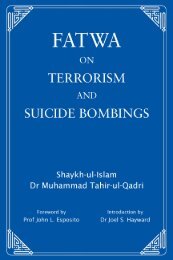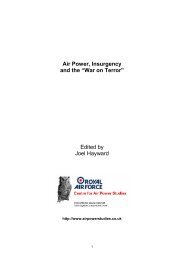Air Power, Insurgency and the âWar on Terrorâ - Prof. Joel Hayward's ...
Air Power, Insurgency and the âWar on Terrorâ - Prof. Joel Hayward's ...
Air Power, Insurgency and the âWar on Terrorâ - Prof. Joel Hayward's ...
You also want an ePaper? Increase the reach of your titles
YUMPU automatically turns print PDFs into web optimized ePapers that Google loves.
<str<strong>on</strong>g>Air</str<strong>on</strong>g> <str<strong>on</strong>g>Power</str<strong>on</strong>g> <str<strong>on</strong>g>and</str<strong>on</strong>g> <str<strong>on</strong>g>Insurgency</str<strong>on</strong>g>: Some Preliminary Thoughts - <strong>Joel</strong> Hayward<br />
for example. Even if <strong>on</strong>e believes that a carefully nuanced air campaign has <str<strong>on</strong>g>the</str<strong>on</strong>g> ability to<br />
change <str<strong>on</strong>g>the</str<strong>on</strong>g> mind of nati<strong>on</strong>al leaders by threatening or c<strong>on</strong>ducting attacks that will hurt or<br />
cost <str<strong>on</strong>g>the</str<strong>on</strong>g>m too much, in counter-insurgency campaigns air forces are ordinarily supporting<br />
<str<strong>on</strong>g>the</str<strong>on</strong>g> nati<strong>on</strong>al leaders whilst <str<strong>on</strong>g>the</str<strong>on</strong>g>y struggles against troublesome sub-state actors. Therefore,<br />
air forces certainly cannot damage nati<strong>on</strong>al infrastructure or high-value “public” objects.<br />
Moreover, <str<strong>on</strong>g>the</str<strong>on</strong>g> misbehaving sub-state actors own almost nothing valuable in a traditi<strong>on</strong>al<br />
sense that air forces can use as objects of coercive leverage.<br />
A denial campaign is equally problematic. <str<strong>on</strong>g>Air</str<strong>on</strong>g> forces would ordinarily undertake this type<br />
of campaign if coerci<strong>on</strong> failed <str<strong>on</strong>g>and</str<strong>on</strong>g> <str<strong>on</strong>g>the</str<strong>on</strong>g>y had to prevent or stop a state from doing harm<br />
with its armed forces. Yet very few insurgent groups in today’s world – <str<strong>on</strong>g>and</str<strong>on</strong>g> nei<str<strong>on</strong>g>the</str<strong>on</strong>g>r <str<strong>on</strong>g>the</str<strong>on</strong>g><br />
insurgents in Afghanistan nor those in Iraq – would attempt a degree of symmetry by<br />
raising armed forces with which <str<strong>on</strong>g>the</str<strong>on</strong>g>y hope to compete in decisive battles against <str<strong>on</strong>g>the</str<strong>on</strong>g><br />
state’s own forces. Instead <str<strong>on</strong>g>the</str<strong>on</strong>g>y deliberately employ guerrilla “hunt <str<strong>on</strong>g>and</str<strong>on</strong>g> pounce” tactics<br />
involving very few of <str<strong>on</strong>g>the</str<strong>on</strong>g> bases, barracks, warehouses, armoured vehicles <str<strong>on</strong>g>and</str<strong>on</strong>g> heavy<br />
weap<strong>on</strong>s that traditi<strong>on</strong>ally form <str<strong>on</strong>g>the</str<strong>on</strong>g> target sets of many denial air campaigns.<br />
It is <str<strong>on</strong>g>the</str<strong>on</strong>g> same even with old-fashi<strong>on</strong>ed punishment strikes which ordinarily occur<br />
retributively when both coerci<strong>on</strong> <str<strong>on</strong>g>and</str<strong>on</strong>g> denial campaigns have failed. Designing target sets<br />
to punish insurgent groups successfully for <str<strong>on</strong>g>the</str<strong>on</strong>g>ir maleficence is almost impossible. The<br />
insurgents rely <strong>on</strong> local populati<strong>on</strong>s for many of <str<strong>on</strong>g>the</str<strong>on</strong>g>ir material needs <str<strong>on</strong>g>and</str<strong>on</strong>g> do so in such<br />
discreet ways that finding valuable targets bel<strong>on</strong>ging <strong>on</strong>ly to <str<strong>on</strong>g>the</str<strong>on</strong>g> culpable within <str<strong>on</strong>g>the</str<strong>on</strong>g> local<br />
civilian communities is virtually unachievable.<br />
A lack of viable independent “strategic” roles in most counter-insurgency c<strong>on</strong>texts does not<br />
mean that air power is of minimal importance or influence against insurgents. Traditi<strong>on</strong>al<br />
“tactical” air power still plays a key role. This usually comprises air-l<str<strong>on</strong>g>and</str<strong>on</strong>g> integrati<strong>on</strong><br />
(although some air forces do also operate closely with maritime forces). The two key<br />
roles of air-l<str<strong>on</strong>g>and</str<strong>on</strong>g> integrati<strong>on</strong> are close air support <str<strong>on</strong>g>and</str<strong>on</strong>g> interdicti<strong>on</strong> <str<strong>on</strong>g>and</str<strong>on</strong>g> <str<strong>on</strong>g>the</str<strong>on</strong>g>y ordinarily<br />
prove highly effective during c<strong>on</strong>venti<strong>on</strong>al warfare. Yet <str<strong>on</strong>g>the</str<strong>on</strong>g> nature <str<strong>on</strong>g>and</str<strong>on</strong>g> physical settings<br />
of modern insurgencies makes <str<strong>on</strong>g>the</str<strong>on</strong>g>se two roles ra<str<strong>on</strong>g>the</str<strong>on</strong>g>r difficult. At <str<strong>on</strong>g>the</str<strong>on</strong>g> heart of close air<br />
support doctrine for c<strong>on</strong>venti<strong>on</strong>al warfighting lies <str<strong>on</strong>g>the</str<strong>on</strong>g> issue of fire-support co-ordinati<strong>on</strong>;<br />
that is, <str<strong>on</strong>g>the</str<strong>on</strong>g> synchr<strong>on</strong>isati<strong>on</strong> of <str<strong>on</strong>g>the</str<strong>on</strong>g> use of weap<strong>on</strong>ry, or “fires,” from above with <str<strong>on</strong>g>the</str<strong>on</strong>g> fires<br />
provided by l<str<strong>on</strong>g>and</str<strong>on</strong>g> forces. This is normally rendered possible by <str<strong>on</strong>g>the</str<strong>on</strong>g> establishment of fire<br />
support co-ordinati<strong>on</strong> lines. These are agreed positi<strong>on</strong>s lying between <str<strong>on</strong>g>the</str<strong>on</strong>g> forward lines<br />
of <strong>on</strong>e’s own troops <str<strong>on</strong>g>and</str<strong>on</strong>g> <str<strong>on</strong>g>the</str<strong>on</strong>g> forward lines of <str<strong>on</strong>g>the</str<strong>on</strong>g> enemy’s troops. They exist to minimise<br />
fratricide <str<strong>on</strong>g>and</str<strong>on</strong>g> to maximise <str<strong>on</strong>g>the</str<strong>on</strong>g> impact of joint fires during c<strong>on</strong>tact battles. In modern<br />
insurgencies <str<strong>on</strong>g>the</str<strong>on</strong>g>re are seldom any lines of troops, friendly or enemy. Fighting smartly to<br />
compensate for <str<strong>on</strong>g>the</str<strong>on</strong>g>ir disadvantages <str<strong>on</strong>g>and</str<strong>on</strong>g> limitati<strong>on</strong>s, <str<strong>on</strong>g>the</str<strong>on</strong>g> insurgents intenti<strong>on</strong>ally fight in<br />
14<br />
<str<strong>on</strong>g>Air</str<strong>on</strong>g> <str<strong>on</strong>g>Power</str<strong>on</strong>g>, <str<strong>on</strong>g>Insurgency</str<strong>on</strong>g> <str<strong>on</strong>g>and</str<strong>on</strong>g> <str<strong>on</strong>g>the</str<strong>on</strong>g> “War <strong>on</strong> Terror”





